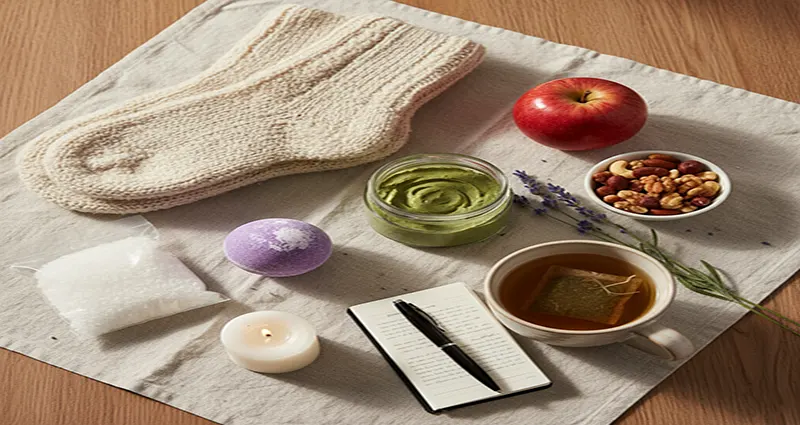How to Create a Healthy Self-Care Package on a Budget
Self-care isn’t a luxury item; it’s a necessity for mental and physical well-being. Unfortunately, the wellness industry often makes it look expensive, filled with pricey spa trips, organic serums, and designer yoga gear.
The truth is, the most effective self-care rituals cost very little. Creating a personalized, budget-friendly “self-care package” is simply about gathering inexpensive items and routines that help you reset. Here’s how to curate a deeply relaxing and healthy self-care package without breaking the bank.
1. Focus on the Five Senses (The Most Affordable Tools)
Your self-care kit should focus on simple items that engage your senses, providing immediate comfort and distraction.
| Sense | Budget Item | Why it Helps |
| Smell | Essential Oils or Incense: Pick up a small bottle of lavender or peppermint oil, or a pack of incense sticks, from a local discount store. | Aromas directly impact mood. Lavender aids relaxation, while peppermint can boost focus and energy. |
Smart Savings: How to Lower Your Monthly Health Insurance Premium with a Higher Deductible
When it comes to health insurance, it often feels like you have to choose between saving money now and being protected later. However, by strategically opting for a higher deductible, you can significantly reduce your monthly health insurance premium, making quality coverage more immediately affordable.
This strategy, typically associated with High Deductible Health Plans (HDHPs), is not a fit for everyone, but for those who are generally healthy and have a plan for unexpected costs, it can be a powerful financial tool.
Understanding the Premium-Deductible Trade-Off
The core concept behind lowering your premium is a simple inverse relationship:
- Low Deductible High Premium: You pay more each month, but the insurance coverage kicks in sooner when you need care. This offers predictability and less financial risk in the event of a sudden illness or injury.
- High Deductible Low Premium: You pay less each month, but you are responsible for
How to Start a Healthy Balanced Diet Without Feeling Restricted
Starting a healthy, balanced diet shouldn’t feel like a punishment. The common perception that “dieting” means endless restriction often leads to burnout and giving up. In reality, a truly sustainable, healthy diet is about addition, not subtraction, focusing on incorporating nourishing foods and building positive habits.
The key to starting a balanced diet without feeling restricted is to embrace flexibility, moderation, and mindful eating. Here’s a simple guide to shifting your mindset and making healthy eating a sustainable part of your life.
1. Shift Your Mindset: Focus on Adding Good Things
Instead of viewing a diet as a list of “off-limits” foods, reframe it as a list of foods you get to eat more of. This psychological shift drastically reduces feelings of deprivation.
- Be a Food Maximizer: Focus on adding nutrient-dense items to every meal. Think: “How can I sneak one more vegetable onto this plate?” or “What
Simple Tips for Choosing the Best Health Insurance Plan as a Self-Employed Individual
Being your own boss comes with a lot of freedom, but it also means taking on the full responsibility of finding your own health coverage. Navigating the options can feel overwhelming, especially when balancing health needs against a fluctuating income.
The key to choosing the best health insurance plan is to move beyond just the monthly premium and focus on your total estimated out-of-pocket costs and anticipated medical needs.
Here are five simple, actionable tips to help self-employed individuals choose the right health insurance plan.
1. Pinpoint Your True Coverage Needs (Be Brutally Honest)
Before you compare a single plan, you need a clear picture of your annual healthcare usage. This determines whether you should favor a low-premium or low-deductible plan.
- Low Expected Use (Generally Healthy): If you rarely go to the doctor and only need preventive care, you might choose a Bronze plan (via the Marketplace) or a High-Deductible
Beginner Tips for Incorporating Mindful Eating into Your Daily Routine
Mindful eating is a practice rooted in the philosophy of mindfulness, which involves bringing full, non-judgmental awareness to the present moment. When applied to food, it’s about tuning into the sensory experience of eating, recognizing your body’s signals, and acknowledging your thoughts and emotions around food. It’s not a diet, but a powerful way to foster a healthier, more intentional relationship with what you eat.
If you’re ready to shift from mindless, distracted eating to a more conscious and enjoyable experience, here are several beginner-friendly tips for incorporating mindful eating into your daily routine.
1. Eliminate Distractions
The most immediate and impactful change you can make is to focus solely on your meal. Distractions—like your TV, smartphone, or laptop—prevent your brain from registering that you’ve eaten, which often leads to overeating.
- Turn off all screens and put your phone on silent.
- Sit at a table (not the couch,














